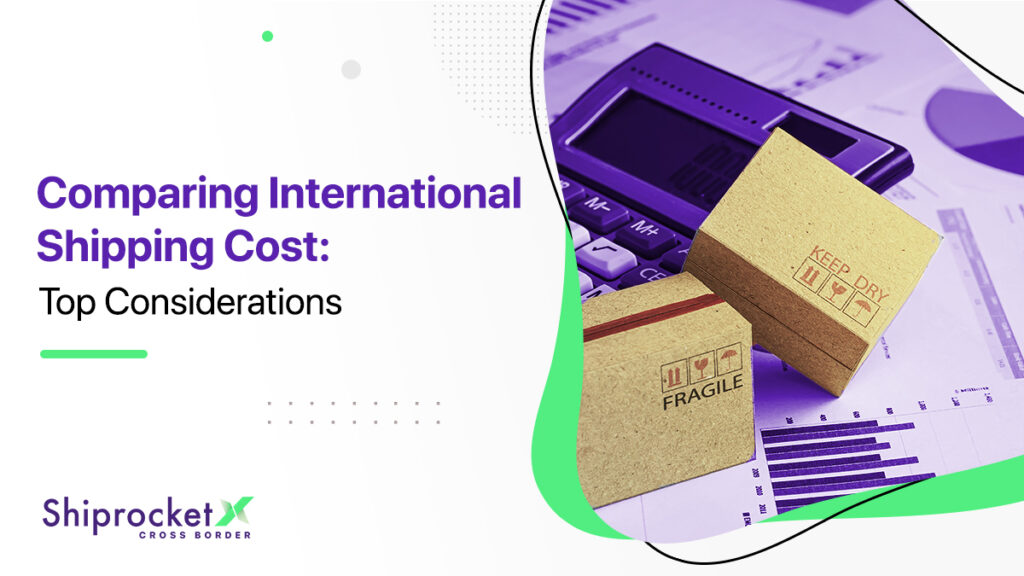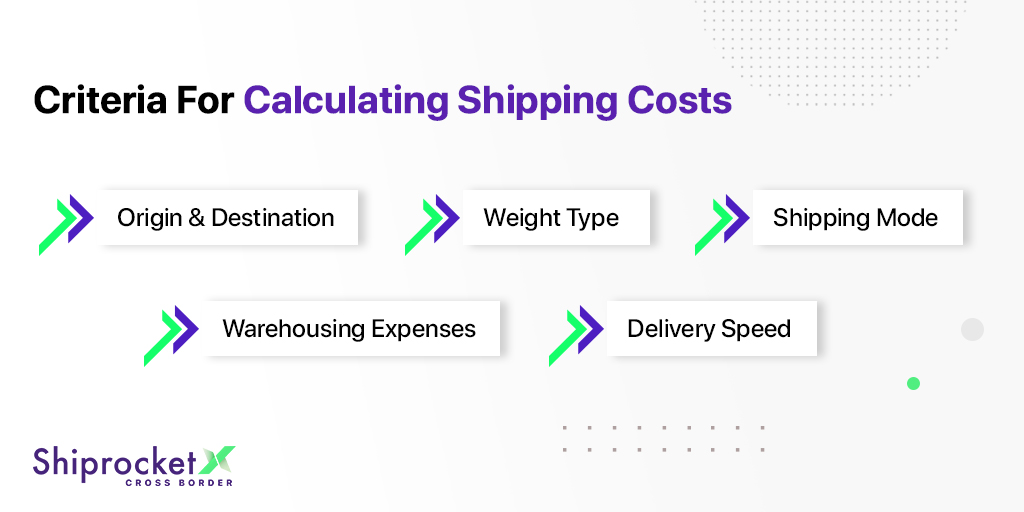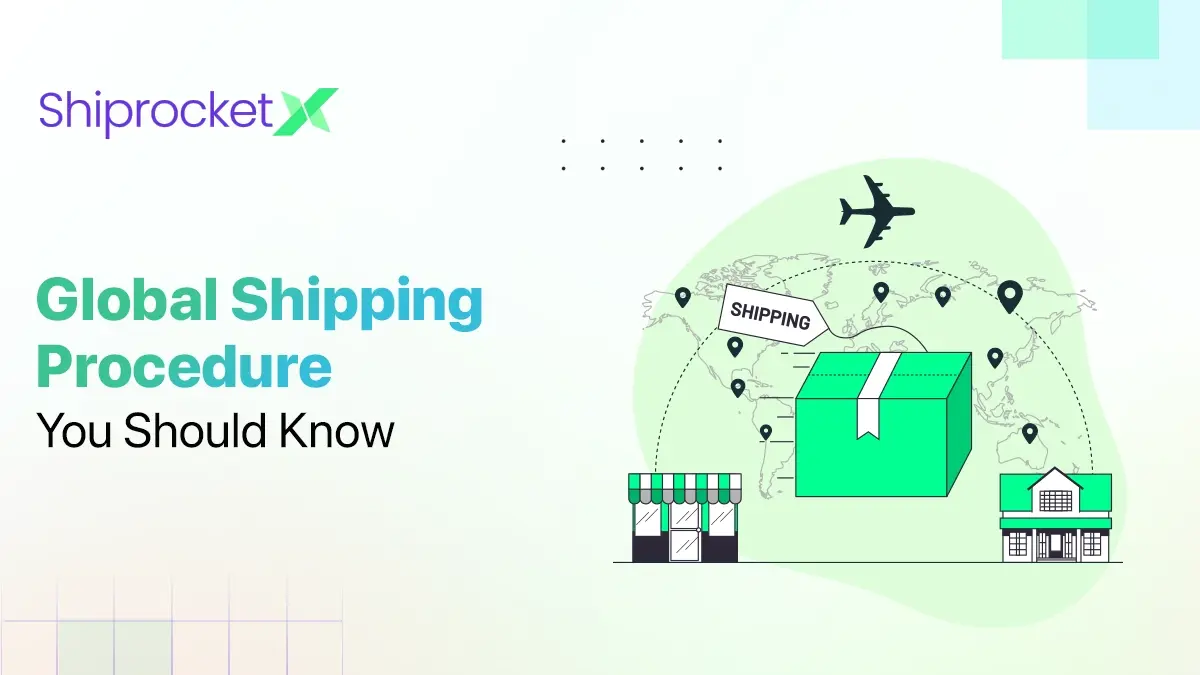Top Considerations While Comparing International Shipping Cost

By January 2022, India’s ocean freight rates increased up to an alarming 15%, and a 10% rise in freight rates affected the U.S. and European retail by more than 1%.
While sellers are quickly getting on the pedestal towards growing opportunities of selling internationally, higher shipping costs accompanying cross-border deliveries still remain an issue.
In such scenarios, how do businesses stay afloat higher international sales while remaining profitable? As a seller, the best way you can do this is by identifying the top factors affecting your shipping rates and decide on the most cost-efficient choice.
What is Shipping Cost?
The direct total cost incurred between picking the package from a shelf in your store or warehouse till the drop at your customer’s doorstep is termed as shipping cost of the package. These costs include
- Cost of packaging (boxes, stickers, labels, and tapes)
- Cost of labor (pack, pick, dispatch)
- Courier charges (collection and delivery)
- Export/Import fee (applicable only for overseas shipments)
How Does It Differ For Global Shipments?
Apart from the former mentioned cost factors, the prime factor in global shipping is landed cost. Landed cost includes a sum of the following cost factors:
- Purchase cost
- Transportation fee
- Duties & taxes
- Currency Conversions
Landed costs always fluctuate, since the tariff varies depending on the country of export. In some countries, there are rigid security measures that delay the delivery process. A thorough knowledge of border policies are essential during such deliveries. In most cases, the import fee is taken up by the buyer, but sometimes the seller and buyer come to a mutual agreement to split the fare.
Information Needed To Calculate Shipping Costs
Irrespective of whether you are a seller shipping your product cross-borders for the first time or for the hundredth time, regularly running a shipping cost comparison ensures you are offering your customers the best deal without incurring any extra losses. To do this, you’ll need a couple of information regarding your courier for an accurate shipping cost calculation:

Origin & Destination
The shipping cost largely depends on the location to which it is being shipped. The further the drop, the higher the rate. For instance, international shipping cost from India to USA will be different from shipping the same package to the US. Leading cross-border courier partners like DHL, FedEx, and Aramex implement these shipping rates as per zones for international deliveries.
Weight Type
Courier partners usually charge your shipment based on the item’s weight (dead weight) or dimensional weight. Weight based pricing depends directly on the weight of your courier, while dimensional weight depends on the packaging’s length, height, and weight. If your parcel is large but light, you may get a shipping cost based on your product’s weight only. In another scenario, if your product is light but heavy, getting your rates based on dimensional weight would be much cheaper.
As a retailer, one must identify the most reasonable weight measurement mode to save expenses.
Shipping Mode
The route of shipping your product from pickup A to Destination B can involve more than one mode of transportation options. The cost differs depending on the carrier mode, whether it is by road, flight or sea. Most shipping companies define shipping zones and carrier mode in their shipping plans to make shipping costs easier to understand and give an enlarged view of how much one has to pay. This is way more efficient and effortless than the conventional mileage-based pricing method.
Warehousing Expenses
Drop and pickup of packages from warehouses isn’t what warehousing expenses are all about. Most often under the eye, the major part of warehouse expense goes into time-consuming tasks such as assembling boxes, inserting dunnage, and securing cartons with tapes and labels. The costs of incurring such extra tasks largely affects your overall shipping costs.
Delivery Speed
Better things come at a cost, and this doesn’t fall short for delivery speed too. The faster you’d like your courier delivered, the higher is the pricing. For small and medium-sized businesses, this becomes a hurdle towards nailing a satisfactory customer relationship. Thanks to shipping aggregators that set a standard delivery charge for specific zones, expenses borne by SMBs and larger enterprises fall at the same pace.
Significance Of Calculating International Shipping Cost
In the era of first mover’s advantage, keeping a track of your competitor’s offers is of utmost importance. For example, your competitor is offering free shipping deals on specific deliveries. While it seems tempting to do the same in order to stay competitive, your profit margins vs expenses may not always balance due to higher shipping costs. When you’re in the loop of your shipping expenses, you can always opt to release flash deals on free shipping when a customer checks out with the order. Not only does this help your business build brand loyalty, but also gives your consumers trust and satisfaction. Result? Why, more sales of course!

Calculating Global Shipping Costs
Taking all these cost factors and information into account, you as a seller have the upper hand in determining the best international shipping cost for your cross border deliveries. Your customized decisions regarding logistics, packaging, transportation and warehousing can help minimize your shipping expenses, with the exception of duty and customs charges.
Conclusion: Opting For An Unified Solution For Minimal Shipping Cost
With an integrated freight planning of shipping prices, you can confidently take your business global without compromising on your customer rapport. Luckily, with Shiprocket X as your logistics partner, this is no more a far-fetched dream.
Shiprocket X allows sellers to directly avail an International Shipping Rate Calculator to compare your shipping rate as per international standard rates. With rates starting at Rs 290/50 gms, you can now ship to over 220+ countries, including US, UK, UAE, and Canada. This smart logistics partner provides you with a one-place stop for inventory management, order fulfillment, automated label generation, faster deliveries, insurance on shipments, among others.






